11Nov 2022
table of contents
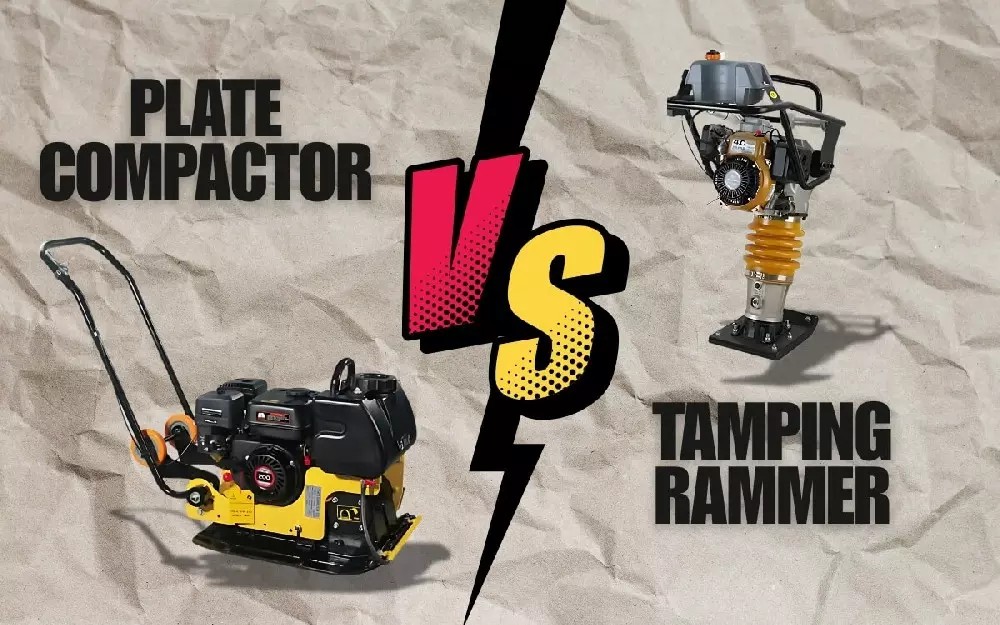
Compaction is one of the most critical steps in many construction projects. When soil is compacted, the particles lock together, which helps prevent settling, shrinkage, and water seepage. An adequately compacted base will ensure the stability needed to properly support structures, walkways, roads, etc.
Depending on the size or type of job, there are several different compaction options, such as vibratory plate compactors and tamping rammers (otherwise known as jumping jacks).
The tools used and compaction requirements may vary from job to job. The expected results are the same; create a solid stable foundation, reduce the severity of settlement, increase resistance, and limit excessive and unwanted movements.
As mentioned above, there are different equipment to choose from, each tool has its own strengths, and it is sometimes difficult to choose the right one for the job. In this article, BISON will compare both tamping rammers and plate compactors to help you choose the best one for your soil compaction needs.
A rammer is a lightweight and portable soil compactor machine that uses the phenomenon of vibration to compact soil. Its sleek body and simple operation allow it to reach into small corners, so it’s the perfect device to use in hard-to-reach places. These machines use gas or diesel power.
Rammers use high-impact forces to mechanically compact the soil. Therefore, they are ideal for road and sidewalk construction where strong soil compaction is required.
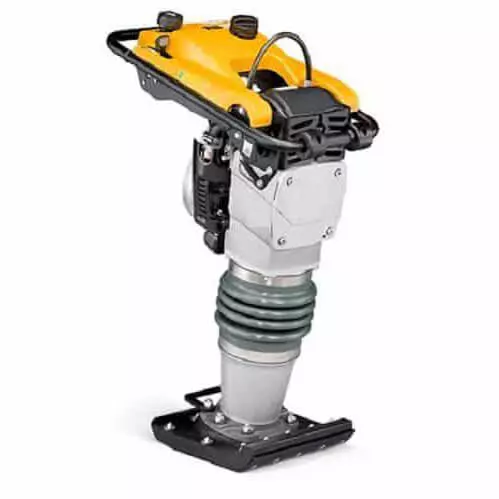
What is rammer?
Clay refers to the type of soil that has a high clay or clay content. The ideal soil for vibratory compaction must contain around 13% moisture. Clay requires a certain amount of water to hold soil particles together firmly.
Vibratory compactors are ideal for cohesive soil types because the smaller plate size provides concentrated and direct compaction. Avoid using a soil compactor on gravel or asphalt, as it can damage the machine.
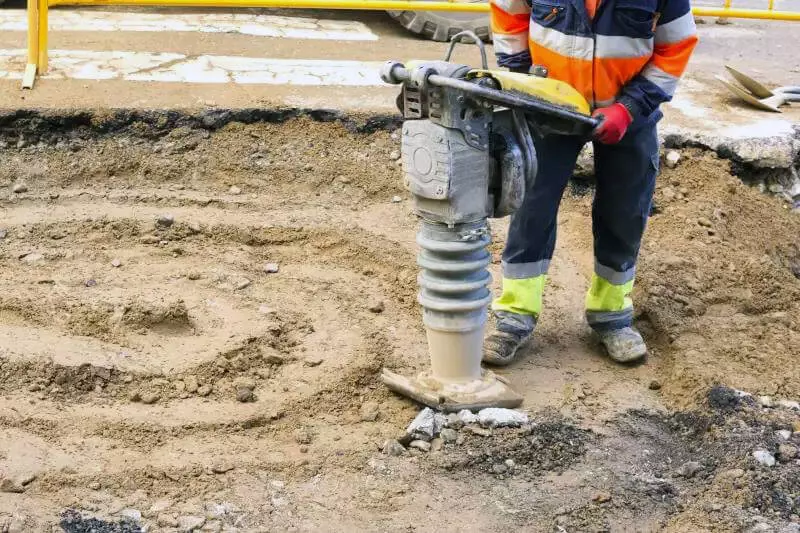
Rammer being used on clay
The smaller size enables it to reach smaller areas, tight spots and trenches where the plate compactor is not easily manoeuvrable.
The smooth construction of rammers allows them to compact deeply into the soil in a dense manner. So by filling more soil in each layer, filling the trench becomes easier.
Useful for compacting soil close to building foundations.
Unlike vibrating plates, rammers work by compacting the soil by direct impact. They provide a powerful force to compress the soil, squeezing out any water and air in the frequency range of around 500-750 beats per minute. Through these impacts, the tamper reduces the number of voids between soil particles and increases the soil’s dry density. This means they are the best choice for compacting cohesive and semi-cohesive soils such as clay.
Rammers, also known as jumping jacks or ramming jacks, are ideal for soils in the 13% moisture range, typically difficult to break and do not crumble when dry. The rammers also feature an upright design with a small footprint, which means they are ideal for use in tight spots, ditches and ditches where there isn’t much room for manoeuvring. The rammer’s base plate (floor) is also not as wide as the base plate of a plate compactor. The rammer also runs on fuel. Please avoid using the rammer on gravel or asphalt, as it can damage the machine.
How deep can the rammer press?
A rammer compacts the soil more profound than a plate compactor. This is a valuable asset for any businessman. Workers not only need to reduce the amount of fill but also reduce the total number of passes. All in all, this results in faster project completion and greater efficiency.
Compact and maneuverable: Tamping rammers are lightweight and easy to move, making them ideal for smaller jobs and confined spaces such as trenches or around obstacles.
Effective on cohesive soils: They excel at compacting cohesive soils, especially clay, providing deeper and more thorough compaction in these materials.
Affordable and fuel-efficient: Tamping rammers are generally more affordable than plate compactors and are available in various models, including 2-stroke, 4-stroke, and electric options.
Ideal for DIY and smaller projects: Their small size and versatility make them a popular choice for DIYers and for use on smaller construction sites or landscaping jobs where larger equipment cannot fit.
Limited on granular soils: Tamping rammers are less effective on granular soils, such as sand or gravel, as vertical compaction force will not compact it properly. Instead, it removes the soil from both sides, drilling it down rather than compacting it.
Limited coverage area: Due to their compact size, tamping rammers cover smaller areas compared to plate compactors, making them less efficient for larger sites or extensive projects.
Physical demands: The repetitive vertical force can be physically demanding for the operator, especially during prolonged use, making them less ideal for large-scale operations that require extended periods of compaction.
Similar to vibratory plate compactors, there are ways to minimize the impact of vibration on an individual. Many sellers offer extra anti-vibration handles for worker health.
When importing a rammer, consider the engine. Most companies have turned to four-stroke engines instead of the old two-strokes to meet EPA emissions standards and overcome performance issues.
Unfortunately, two-stroke rammers offer several beneficial features, including the ability to add oil on the spot (instead of doing an oil change and stopping work). Fortunately, there are two-stroke engines on the market, and the famous Wacker Neuson continues to produce EPA-compliant two-stroke engines.
Consider importing a rammer with a removable water tank, and check the shoe’s stroke technique, compaction force, balance, and strokes per minute before making a decision.
Rammers are available in various sizes and accessory options to meet specific site needs. Some unique variables that define rammers include engine type (two-stroke, four-stroke or diesel), shoe size, weight, travel speed and impact force. The following factors must always be considered before investing in rammers.
A rammer is usually tilted at an angle when compacting the soil, so operating weight plays a vital role in selecting equipment. The mechanic uses the handle provided on the top of the machine for operation. The lower part of the rammer has a plate that compacts the soil. An engine powered by diesel or gasoline powers the system, and the rammer’s efficiency depends on the engine’s capacity.
The engine’s power is transmitted through the whiplash system and the foot, creating the impact. The frequency range of this compaction force is 500-700 beats per minute. As a result, vibratory rammers tip forward during operation, so the machine always needs extra care.
Plate compactors are necessary equipment on any construction site. They come in a variety of sizes and styles for efficient compaction. Flat-bed compactors use heavy-duty steel plates mounted on the bottom of the machine. These machines are similar to push mowers but have different purposes.
This versatile device offers a variety of extensions and accessories to make the compaction process even easier. A flat slab powered by diesel or gas is at the heart of the machine. The immediate impact and gravity applied by the machine tread the soil even tighter, eliminating the risk of future settlement.
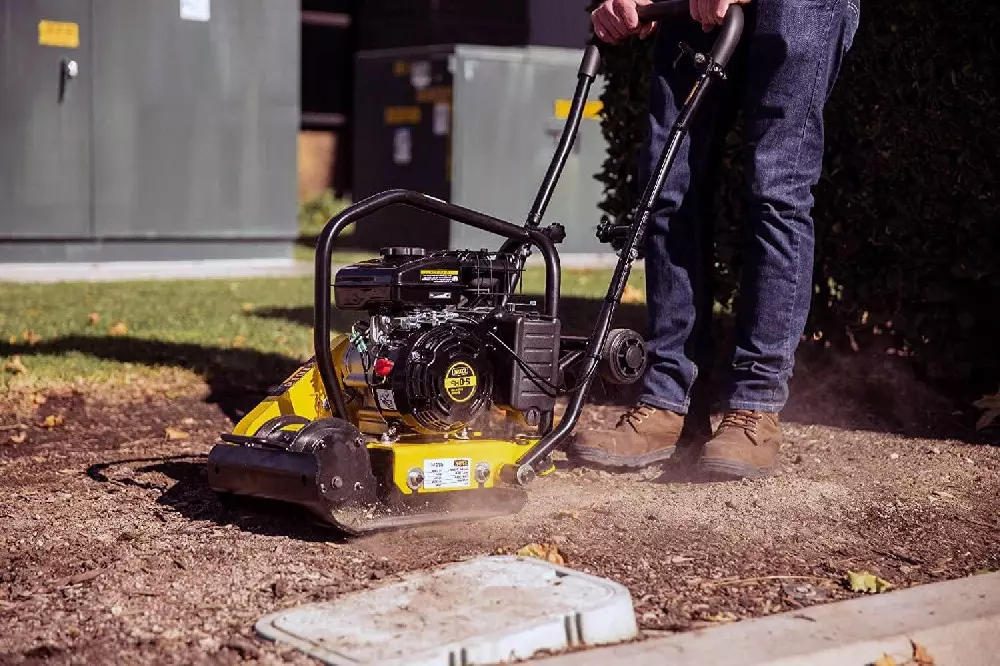
What is a plate compactor?
Granular soil is loose soil composed of silt, gravel, and sand. Such soils can be compacted whether they are dry or wet. They are brittle and have no cohesive strength, so different equipment is required to reduce density. A plate compactor is ideal for granular soil types as it responds well to high vibrations. The weight and frequency of vibration eliminate air and space between particles.
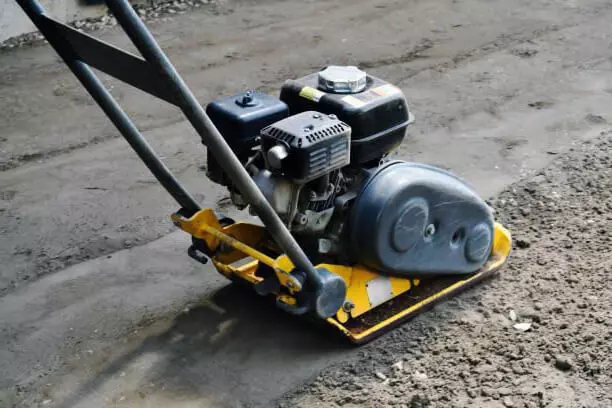
Plate compactor on granular soil
Due to the ergonomic design, the plate compactor is suitable for more extensive and flat areas. Most compactors have broad bases, making them ideal for open spaces. Therefore, this heavy equipment is ideal for driveways and parking lots in open areas where the machine can easily compress.
Suitable for compacting asphalt layers in roadwork and driveways.
Ideal for leveling and compacting paving stones and blocks.
Plate compactors use vibration to get the job done. You push the machine across the compacted surface, and its heavy slab vibrates up and down to compact the soil. This movement forces the soil below to pile up.
Plate compactors run on diesel or gas. Plate compactors are also suitable for larger areas. This is simply because of the ease of use. Most road rollers are very wide, making them more suitable for open spaces. Also, plate compactors are better for flat surfaces and provide an even layer over these areas. Therefore, the device is ideal for ground and asphalt driveways, parking lots and repairs.
Efficient on granular soils: Granular soil consists of visible fragments of rock, gravel, sand, and fine particles. Unlike cohesive soils, granular soils do not hold together when compacted and separate rapidly when disturbed. Plate compactors are ideal for compacting granular soils like sand and gravel, providing uniform and efficient compaction over large areas.
Faster than tamping rammers: They cover more ground in less time, making them more suitable for larger projects. It is more efficient than a rammer because it can work three to four times faster.
Variety of models: Plate compactors come in forward and reversible models, and available in multiple sizes and configurations, offering versatility for a wide range of applications, from small pathways to large paving projects.
Smooth, even finish: The vibration creates a smooth, even surface, which is particularly beneficial for paving and other flat surface projects.
Less effective in tight spaces: Due to their larger size, plate compactors are less maneuverable in confined or narrow spaces.
Ineffective on cohesive soils: Plate compactors do not perform as well on cohesive soils like clay, where deeper compaction is needed.
Heavier and harder to move: They are bulkier than tamping rammers, making them more challenging to transport and store.
Higher cost: Plate compactors have a higher upfront cost compared to tamping rammers, which may not be cost-effective for smaller projects.
Plate compactors compact to different depths, and because they come in many different sizes, the force they drive to the ground varies. Also, the soil type will determine the thickness of the soil layer your compactor can handle. If you are lucky enough to own a large, industrial-size compactor, it is recommended to layer or “lift” 12 inches when working with granular soils.
You may want to cut this number in half if you use clay soil. The lift for one compaction should not exceed 6 inches for smaller compactors. Likewise, if using cohesive soil, halve that number. The compactor you purchase specific recommendations, so be sure and check your owner’s manual on how to best use your machine.
Before deciding to use a plate compactor, carefully consider its characteristics such as vibrations per minute (VPM) and plate durability.
Professionals should rely more on amplitude and weight to understand performance than centrifugal force.
Plate compactors are relatively bulky but still come in a variety of sizes. Depending on the size of your project, you can choose the base plate size, travel speed, and power of your equipment. These plate compactors feature a wear-resistant iron base plate that provides strength to the system. The engine is powered by diesel or gasoline to provide energy for the thrust.
Most compactors have a pull-start gasoline engine with a choke to start the machine. Just flip the switch and pull the choking cord to start the engine. The plate compactor moves forward independently but requires you to constantly guide and manipulate the handle. It needs some resistance to control the movement of the device entirely. Flip the power switch to shut down the machine quickly, but let it cool down before changing gears.
Both rammers and plate compactors have unique uses. If you can’t decide on which machine to choose, put both of them in your fleet and enjoy an efficient and hassle-free soil compaction process.
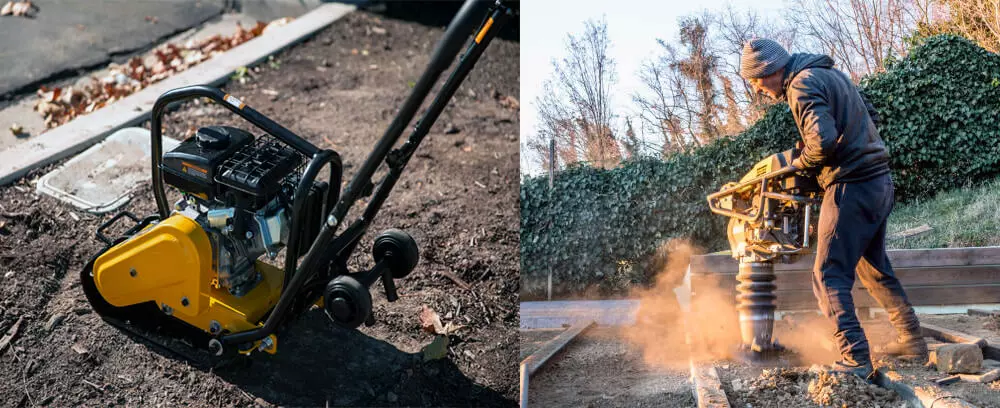
Now that we are familiar with rammers and plate compactors, it would be nice to introduce their differences. As you know, each of these devices is designed and built for a specific purpose. But there are some significant differences between them, some of which are mentioned:
The compaction or hitting of the centre of the soil is different in each of these devices. In this way, the plate compactor uses a reciprocating motion for this purpose, and the jumping jack rammers hit the centre of the soil vertically, utilizing bumps and jumps.
Therefore, the type of operation of each device is different, and their respective types of functions and efficiencies are different.
Regarding how to use each of the above equipment, it must be admitted that using a earth rammer is more accessible than a compactor. In general, however, working with each of them requires expertise.
But it"s easier to use a plate compactor than a rammer.
Rammer can cause more severe strikes than a plate compactor due to its greater power and capacity than the vibrating plate compactor.
As before, the rammers apply their force vertically in the centre of the soil and do so with greater force. That’s why it’s better for working in tight spaces like pits and passages than in a plate compactor.
However, if the soil has a sticky layer and small particles, use a plate compactor instead of a rammer because the vibration and vibration modes of the plate compactor are sufficient to stabilize and unify the soil.
Plate compactors are larger than rammers and this is why the use of plate compactors results in more pounding and compaction of the surface, requires more storage space, And is more heavier, harder to move. While rammer is compact, lightweight, easy to transport and store.
Tamping rammers are lower purchase or rental cost, with decent fuel efficiency. Plate Compactors are Higher initial costs, but cover larger areas more quickly, potentially saving time.
As you can see, each of these compactors serves a specific purpose. But both in appearance, as well as in the way and strength of the beatings, they are all different.
Because their respective application types and efficiencies vary according to the structure of the device in question, each is well used in different situations.
About BISON
At BISON, we sell quality construction equipment and tools, including plate compactors and rammers. Our compaction products are manufactured and tested to the highest quality standards, ensuring adequate, fast, efficient and safe compaction. Visit our online store today to import our compaction equipment online. We are wholesalers which means the company’s customers can get a better price for all the compaction equipment.
Choosing between these machines is not as simple as one might think. While they both compact the base material, they compact different soil types differently.
Every situation is different, and it is crucial to fully understand the job requirements and soil type you will be using.
However, a general rule of thumb for rammers and compactors is:
A rammer is usually ideal if you are working with cohesive soils for trenching. Its shape makes it easy to handle, and the smaller, more concentrated plate allows for deeper compaction, so you don’t need multiple passes to fully compact the material in deep trenches or holes.
A plate compactor is usually your best choice if you’re compacting granular soil over a large, flat area. Its wider plate size and vibration properties allow for more uniform layers over larger square feet.
The simple answer is Yes. In most cases, it’s recommended to wet the soil before compacting. Because it helps to reduce the friction between dirt particles and this ultimately reduces the time needed for the dirt to compact.
A plate compactor is usually your best choice if you’re compacting granular soil over a large, flat area. Its wider plate size and vibration properties allow for a more uniform layer over more extensive square footage.
Although rain will moisten the soil and will help with compaction it’s not recommended to do compaction if the rain is heavy. It can put your safety at risk and it will be difficult for you to work in the mud.
inquiry form here
BISON BLOG, All the latest news and views from Bison Machinery.